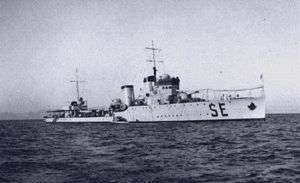Sella-class destroyer
 Destroyer Sella at anchor | |
| Class overview | |
|---|---|
| Builders: | Pattison, Naples |
| Operators: | |
| In commission: | 1926–1940s |
| Completed: | 4 |
| Lost: | 2 |
| Retired: | 2 |
| General characteristics | |
| Type: | Destroyer |
| Displacement: |
|
| Length: | 89.4 m (293 ft 4 in) |
| Beam: | 8.6 m (28 ft 3 in) |
| Draught: | 2.7 m (8 ft 10 in) |
| Propulsion: |
|
| Speed: | 35 knots (40 mph; 65 km/h) |
| Range: | 1,800 nmi (3,300 km) at 14 kn (16 mph; 26 km/h) |
| Complement: | 153 |
| Armament: |
|
The Sella-class destroyers were a ship class of destroyers built for the Italian Regia Marina in the 1920s. Two of these ships fought in World War II and both were sunk after the Italian capitulation to the Allies. Two more ships were sold to the Swedish Navy in 1940 and were scrapped in the late 1940s.
These ships formed the basis for most subsequent destroyers built by the Italians, but were disappointing in service with unreliable machinery.
During the War, the destroyers were based at the island of Leros, in the Dodecanese. They took part in the Italian retaking of Kastelorizo (named Operation Abstention by the British) on 27 February 1941, and were used as mother ships for the attack by explosive motor boats on HMS York on 25 March. Crispi led the landing of an Italian division on Sitia, Crete, on 28 May 1941, in the course of the battle of Crete.
Ships
All four ships were built by the Pattison shipyard in Naples
- Francesco Crispi -
- Named after Francesco Crispi,
- completed 29 April 1927,
- seized by the Germans after the Italian Armistice in September 1943, served as TA15, sunk by air attack on 8 March 1944 in the Aegean Sea.
- Quintino Sella -
- Named after Quintino Sella,
- completed 25 March 1926,
- sunk by German E-boats on 11 September 1943 in the Adriatic Sea.
- Named after Bettino Ricasoli,
- commissioned 11 December 1926.
- Sold to the Swedish Navy as HSwMS Puke.
- Giovanni Nicotera -
- Named after Giovanni Nicotera,
- commissioned 8 January 1927.
- Sold to the Swedish Navy as the HSwMS Psilander.
Sources
- Whitley, M.J. (1988). Destroyers of World War 2. Cassell Publishing. ISBN 1-85409-521-8.
- - Tragedy destroyer Quintino Sella 11 września 1943 r. (PL)